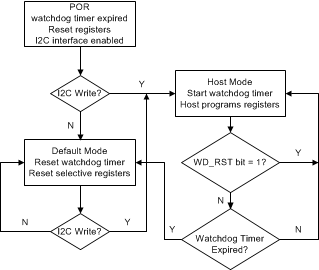ZHCSIJ0B July 2018 – February 2022 BQ25601D
PRODUCTION DATA
- 1 特性
- 2 应用
- 3 说明
- 4 Revision History
- 5 说明(续)
- 6 Device Comparison Table
- 7 Pin Configuration and Functions
- 8 Specifications
-
9 Detailed Description
- 9.1 Overview
- 9.2 Functional Block Diagram
- 9.3 Feature Description
- 9.4 Device Functional Modes
- 9.5 Protections
- 9.6 Programming
- 9.7
Register Maps
- 9.7.1 REG00 (address = 00) [reset = 00010111]
- 9.7.2 REG01 (address = 01) [reset = 00011010]
- 9.7.3 REG02 (address = 02) [reset = 10100 010]
- 9.7.4 REG03 (address = 03) [reset = 001 0001 0]
- 9.7.5 REG04 (address = 04) [reset = 01011000]
- 9.7.6 REG05 (address = 05) [reset = 10011111]
- 9.7.7 REG06 (address = 06) [reset = 01100110]
- 9.7.8 REG07 (address = 07) [reset = 01001100]
- 9.7.9 REG08 (address = 08) [reset = xxxxxxxx]
- 9.7.10 REG09 (address = 09) [reset = xxxxxxxx]
- 9.7.11 REG0A (address = 0A) [reset = xxxxxx00]
- 9.7.12 REG0B (address = 0B) [reset = 00111xxx]
- 10Layout
- 11Device and Documentation Support
9.3.5.1 Host Mode and Default Mode in BQ25601D
The BQ25601D is a host controlled charger, but it can operate in default mode without host management. in default mode, the device can be used as an autonomous charger with no host or while host is in sleep mode. When the charger is in default mode, WATCHDOG_FAULT bit is HIGH. When the charger is in host mode, WATCHDOG_FAULT bit is LOW.
After power-on-reset, the device starts in default mode with watchdog timer expired, or default mode. All the registers are in the default settings.
in default mode, the device keeps charging the battery with default 10-hour fast charging safety timer. At the end of the 10-hour, the charging is stopped and the buck converter continues to operate to supply system load.
Writing a 1 to the WD_RST bit transitions the charger from default mode to host mode. All the device parameters can be programmed by the host. To keep the device in host mode, the host has to reset the watchdog timer by writing 1 to WD_RST bit before the watchdog timer expires (WATCHDOG_FAULT bit is set), or disable watchdog timer by setting WATCHDOG bits = 00.
When the watchdog timer expires (WATCHDOG_FAULT bit = 1), the device returns to default mode and all registers are reset to default values except IINDPM, VINDPM, BATFET_RST_EN, BATFET_DLY, and BATFET_DIS bits.
 Figure 9-1 Watchdog Timer Flow Chart
Figure 9-1 Watchdog Timer Flow Chart